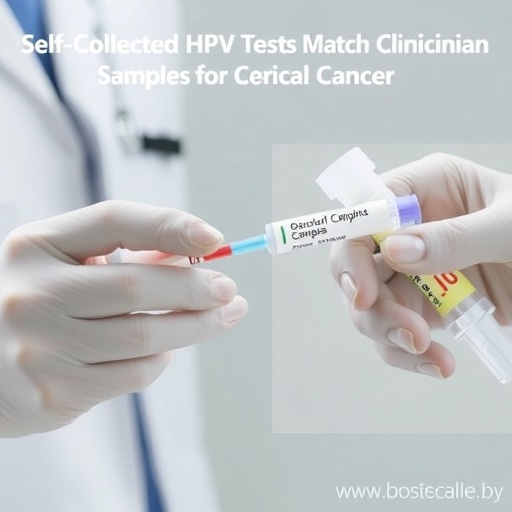In the landscape of cervical cancer screening, a groundbreaking study has emerged shedding light on the efficacy of self-collected human papillomavirus (HPV) samples, which presents a strong alternative to the traditional clinician-collected samples. Researchers, led by Ruben, Narasimhan, and Nolan, have conducted an innovative examination aiming not only to revolutionize cervical cancer screening methodologies but also to enhance accessibility and comfort for individuals. The study brings forward compelling evidence that self-collection can be just as effective, specifically in populations that may hesitate to seek clinical screening due to various social, economic, or cultural barriers.
For decades, clinician-collected samples have been the gold standard in cervical cancer prevention strategies. Women visited healthcare providers to have samples collected, which were subsequently tested for the presence of high-risk HPV types associated with cervical cancer. However, the traditional model has its limitations, particularly in fostering universal screening uptake among underrepresented populations who may face challenges such as stigma, lack of access to healthcare facilities, or even fear of clinical settings. This study’s findings challenge the status quo by suggesting that self-collection could bridge that gap effectively.
Substantial research has pointed to the significance of early detection in reducing cervical cancer incidence and mortality. The use of HPV testing as a primary screening tool has become a crucial game-changer in this regard, offering greater sensitivity in detecting potential precursors to cancer. However, convincing women to participate in screening remains a challenge. The authors of this study delve into how the option for self-collection may influence women’s willingness to engage in regular screening practices.
Intriguingly, the findings of the study indicate that self-collected samples demonstrate non-inferiority to clinician-collected samples in terms of HPV detection rates. This revelation is pivotal as it validates self-collection as a practical method. With technological advancements, the process of self-collection is made easy, eliminating the need for extensive training for both providers and patients. Participants can carry out the screening at home, introducing a level of autonomy and privacy that may empower women and incentivize participation.
Alongside the convenience, the authors provide insights into the psychological aspects of self-collection. The feel of control and privacy could lead to a heightened willingness to participate in cervical cancer screenings. Research has consistently shown that personal agency can significantly impact individuals’ health-seeking behaviors. When women can manage their health screenings, it may create a more positive perception of the process itself, reducing anxiety and discomfort associated with traditional visits.
Moreover, the implications of this shift toward self-collection reach beyond personal comfort; it also underscores the potential for improved public health outcomes. By offering a self-collection option, public health campaigns could engage populations who are typically hard to reach. Accessibility increases significantly, especially in regions with limited healthcare infrastructure. For populations that are geographically and economically marginalized, self-collection can be a transformative intervention.
The study also discusses the clinical implications of these findings. If self-collected samples prove to be a reliable alternative, healthcare systems can redesign workflows, making them more efficient. This model can conserve healthcare resources, allowing providers to focus on women who have tested positive for HPV, thus utilizing their time and efforts to address high-risk cases more effectively.
A critical analysis of the self-collection method reveals various technical aspects as well. The study meticulously evaluates the accuracy, sensitivity, and specificity of testing protocols. As screenings can be processed in laboratories with robust procedures, the necessity for stringent quality assurance becomes paramount. The viability of self-sampling hinges on the quality of samples collected and the subsequent processing techniques employed in laboratory settings, ensuring that the reliability of screening outcomes remains uncompromised.
Throughout the study, the authors underscore an essential consideration: education surrounding self-collection. For self-collection to succeed on a larger scale, educational initiatives must inform potential participants about the process and its significance. Dismissing misconceptions and providing clear guidance will foster a sense of trust and will encourage acceptance amongst women, equipping them with the knowledge necessary to make informed health choices.
Furthermore, as healthcare continues to evolve, the ethical implications of self-collection must be recognized. The study touches upon the need for informed consent and thorough understanding among participants regarding the procedure’s implications. Empowering women through knowledge and autonomy should always be balanced with ethical considerations to ensure ongoing trust in self-collecting methods.
The authors conclude with a visionary viewpoint, advocating for health systems worldwide to adopt and integrate self-collection into routine screening practices. The synergy between technology, public health, and personal agency positions self-collection as a revolutionary advancement in cervical cancer prevention strategies. Each of these facets collectively supports a future where cervical cancer screening becomes more inclusive, efficient, and effective at a global level.
In summary, this pivotal research opens doors for transforming cervical cancer screening as we know it. Self-collected samples present an innovative approach that confronts barriers of access, psychology, and clinical efficiency head-on. The study implores the medical community to embrace this alternative, thereby fostering a proactive culture surrounding women’s health.
As the discussion continues on self-collection methods, the emphasis remains clear: women deserve accessible, empowering, and effective healthcare solutions. The study’s findings not only challenge conventional practices but also inspire a collective commitment toward improving cervical cancer screening across various demographics, ultimately driving results that can save lives.
Subject of Research: Self-collected human papillomavirus cervical cancer screening
Article Title: EBM BLS: Self-collected Human Papillomavirus Cervical Cancer Screening Is Non-Inferior to Clinician-Collected Samples
Article References:
Ruben, C., Narasimhan, S. & Nolan, E. EBM BLS: Self-collected Human Papillomavirus Cervical Cancer Screening Is Non-Inferior to Clinician-Collected Samples.
J GEN INTERN MED (2025). https://doi.org/10.1007/s11606-025-09830-x
Image Credits: AI Generated
DOI: 10.1007/s11606-025-09830-x
Keywords: Cervical cancer, self-collection, human papillomavirus, screening, public health.
Tags: accessibility in cervical cancer testingbarriers to clinical screening for HPVcervical cancer screening methodologiesclinician-collected cervical cancer samplescomfort in self-collection for womenearly detection of cervical cancerhigh-risk HPV types and cervical cancerHPV detection in underrepresented populationsinnovative cancer screening solutionspublic health and cervical cancer preventionself-collected HPV testsself-collection vs clinician-collection in healthcare





